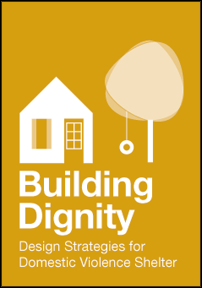"We found many of our rules unnecessarily controlling, and found they did not foster the environment of empowerment that we wanted to create in our program... we agreed that it would not hurt to try a new approach to our services, especially one that is designed to promote empowerment." - Tautfest
"Although advocates are often pushing systems, communities and individuals to change behaviors and attitudes about violence against women, it is not as easy for advocates to change their own systems." - MCADSV
 Building Dignity: Design Strategies for Domestic Violence Shelter
Building Dignity: Design Strategies for Domestic Violence Shelter
Thoughtful design dignifies survivors by meeting their needs for self-determination, security, and connection, while supporting parenting and minimizing the need for rules. This project of the Washington Coalition Against Domestic Violence reflects a commitment to creating welcoming, accessible environments that help to empower survivors and their children, and have their origins in conversations with shelter residents and advocates. The site is designed to be useful to advocates, executive directors, architects and designers.
"When I wanted to implement some physical fixes and we didn't have the money, I went to the community and asked for it. I can't believe how much you can get when you ask for it!" - WSCADV









